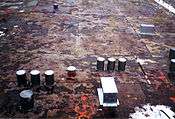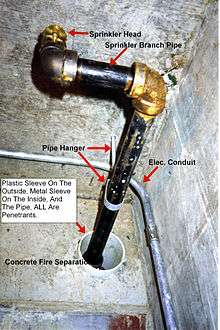Penetration (firestop)
A penetration, in firestopping, is an opening, such as one created by the use of a cast-in-place sleeve, in a wall or floor assembly required to have a fire-resistance rating, for the purpose of accommodating the passage of a mechanical, electrical or structural penetrant. The penetration may or may not contain a firestop system. A penetration is not a penetrant. A penetration may or may not include a penetrant.
Old terminology
The nuclear industry in particular used to refer to firestops as "penetration seals" or "penseals". These terms are superseded by the term firestop. Whereas penetration seals or penseals only dealt with openings made to accommodate penetrants, firestops now also include Joint (building).
Why the term "Penetration (firestop)"?
It is useful to have clarity in construction communications, to differentiate between the opening, whether sealed or not, and the penetrants, which are optional components of a penetration, as sometimes openings (penetrations of the fire barrier) are created for future use, especially in electrical service rooms. A firestop, after all, tends to be easier to remove than concrete, which requires coredrilling equipment, cooling water, etc. A firestopped penetration may also be referred to as a firestop, as a firestop, by definition, is a system. Therefore, the terms firestop and penetration can at times be deemed to be interchangeable.
Images
-

Sheet metal cans are nailed to form boards where concrete is about to be cast. The cans are located by the plumber. Once the penetrants are in place, one can firestop.
-

A penetration, in this case without a firestop.
-

A firestopped penetration
See also
External links
- Penetration seals (firestops) treatise by Warrington labs
- Penetration seals (firestops) treatise by Nuclear Regulatory Commission
- Penetration seal (firestop) vendor listings by Thomas Register